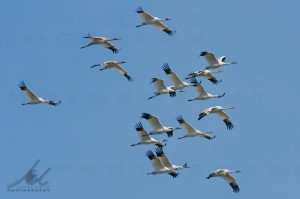by Chester McConnell, Whooping Crane Conservation Association
Some whooping cranes are heading north. They are departing from Aransas Refuge on the Texas coast. They’re on their way to Canada’s Wood Buffalo nesting grounds 2,500 miles away. Only a small number from the Aransas/Wood Buffalo flock have departed from Aransas but others will soon follow. According to Dr. Wade Harrell, U.S. Whooping Crane Recovery Coordinator: “It appears that some whooping cranes have started to migrate back north, which is several weeks earlier than normal. Perhaps this is not surprising given the unusually warm and dry winter that the southern plains have experienced.”
March brings restlessness to the wintering cranes as days get longer. Cranes of the Aransas/Wood Buffalo flock could encounter dangerous cold and stormy weather if they move north too rapidly. But, whoopers heading to Canada must race for their nesting grounds where summers are short. Adult pairs have to build a nest, lay two eggs and incubate the eggs for 30 days when the chicks hatch. Then they must feed the chicks large amounts of food to get the youngsters ready for the long migration back to Texas. So, whoopers have much to do in a short time on the nesting grounds. Hopefully the northern habitats will be thawed and ready for nesting when they arrive. Most of the Wood Buffalo nesting area is still currently frozen. But whooping cranes are wise and the migration to Canada normally requires 40 to 60 days.
So most likely icy conditions will change before most of the cranes arrive there.Yet, whoopers are definitely in their migration mode. Citizen whooper watchers have reported birds in northern Texas, Oklahoma, Kansas and Nebraska. Eight whoopers were reported as far north as North Platte, Nebraska. Migration records kept by the Whooping Crane Conservation Association indicate about two dozen birds along the migration route. Some of these observations have been verified by U.S. Fish and Wildlife Service refuge managers.
Hopefully all the whooping cranes currently on the way to Canada and those waiting on Aransas Refuge, Texas will have a safe 2,500 mile migration. We know that, sadly, two members of this flock will not be with them. They were shot and killed during the past year, one by a poacher (South Dakota) and the other by a hunter (Texas). Both of the men who killed the whoopers have been prosecuted and received large fines and other punishment. The Whooping Crane Conservation Association urges state and federal wildlife agencies and birding organizations along the migration route to increase their efforts to educate hunters and other citizens about the compelling need to help protect endangered whooping cranes.
Interestingly, Dr. Harrell’s “Wintering Whooping Crane Update” report (3/7/2013) described the movements of one whooper family that has GPS transmitters attached to them: “Update February 24: The marked family group (two adults and one juvenile) from Granger Lake left arriving in North Texas that evening. They stayed through Feb. 28 and then moved to SW Oklahoma where they remained through March 2. They then moved on to Quivira National Wildlife Refuge in South Central KS, a traditional migration stopover site for whooping cranes, where they currently remain.”
More about whooping crane migration can be learned by reading The Whooping Crane Tracking Partnership’s recently issued biannual report. The following is a summary of the data captured from the 2012 breeding season through fall migration (approximately May through November). Background information about the Partnership can be found on the following link: https://whoopingcrane.com/tracking-whooping-cranes-telemetry-update/
Excerpts from the report: “During the 2012-2013 season, information was gathered about location from 36 transmitters during the breeding season and data from 30 transmitters during fall migration. Prior to migration, six transmitters stopped providing data. With the help of the technology, the mortalities of two juveniles and two subadults were confirmed on the breeding grounds of Wood Buffalo National Park. The two other transmitters were confirmed to have broken antenna. The tracking technology also revealed that three cranes spent the summer months in south-central Saskatechewan and 29 marked birds completed the fall migration.”
“The birds began their fall migration from Canada on September 7, 2012, and data indicates that all of the birds arrived on the Texas coast by November 27, 2012. It took the cranes an average of 46 days to make the migration with the migration time ranging from 21 to 67 days. The data shows whooping cranes used 261 different locations where they stopped and stayed for more than one night. Stopover locations occurred in every state and province in the Great Plains. Cranes spent the most time at staging sites in Saskatchewan and the Dakotas. The general migration corridor used was similar to past migrations and there were no mortalities detected during the migration.”
“The GPS tracking devices attached to the whooping cranes are programmed to record four locations daily and provide both daytime and nighttime locations. Transmitters upload data approximately every 2.5 days allowing for monitoring survival. The technology allows biologists to learn which habitats are being used and where the birds stop during their migration – important information when prioritizing management decisions.”
The Whooping Crane Conservation Association supports the Whooping Crane Tracking Partnership’s in hopes that the information they collect will help in the improved management of the whoopers.


